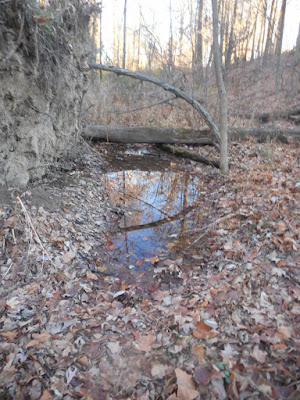Kojak Storm II
November 21, 2015
(and an Update for November 22, 2015)
It finally happened!
A real rain – steady, constant, plentiful, and for long
hours.
Enough to get the Creek running again.
Enough to fill up Cottonwood Pond again.
Enough to get the Seep seeping again.
The Seep
The Bark Ledge where the Seep
meets the Creek
Enough to bring forth the mushrooms!
 |
These look like they should be called "Eggs of the Woods"
And enough to entice Kojak, the neighbor's Doberman, to follow
me down to Cottonwood Pond again for a good doggy splash.
Water was running down the Temporary Creek again, from the
southeast, toward Cottonwood Pond …
...then into the Swampy Place.
The remnants of Monkey Flower plants
Water has been gradually pushing this stray ball closer toward Cottonwood Pond
Soggy Crawdad chimneys
It went under the Trunk ...
... and into "little pond" ....
...and then under the Barkless Log, through the Inlet, and
into the main Pond ...
Soggy area, Inlet and Pond
Above the Barkless Log, with the Pond on the right
The Pond side of
the Inlet
View of Pond and Inlet from the northwest
… filling it up so that Kojak could have a nice, fresh drink.
Ah! At Last!
It was good to feel the rain falling and know that Cottonwood
Pond was being refreshed and revived …
… including Kojak.
***************************************************************************************
Bonus rainy day photos:
Water running down the side of a tree, and …
...pouring into a niche at the tree's base.
*********************************************************************************
Update
November 22, 2015
The next day, I decided to go on a 60th Birthday
Walk in my woods. It had rained all night, too. I checked on Cottonwood Pond on
the way back.
View of Cottonwood Pond from the northwest. To the
left of the Ash tree is the Root Ball Top, “little pond” and the Trunk. To the
right of the Ash tree is the Root Ball Bottom and the main Pond.
There was a little more water in the main Pond. The water was
very calm and clear.
And “little pond” had filled up overnight.
The fallen leaves had been sinking beneath the water and
starting to darken.
It looked like water had been moving through the Cove (which
it had not been the day before.)
**************************************************************************************






































































